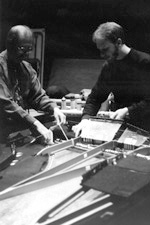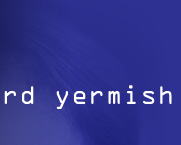Ritual (1997)
bowed piano and percussion ensemble (12 players)
- Meditation
- Fire Dance
- Conjuration
- Dance of Ecstasy and Sacrifice

Howard Yermish and Stephen Scott prepare the piano for bowing before a performance with the Los Angeles Chamber Orchestra.
Notes on the Composition:
Even for the most elite musicians, the notion of a bowed piano usually raises a few eyebrows. "How do you get the bow inside?" I hear you cry. While a bowed piano may seem strange to most, it is not without precedent. Dating back to 1575, Hans Haiden of Mureberg invented the Geigenwerk, a bowed keyboard instrument where pressing a key would lower a string against one of several rotating parchment-covered wheels, controlled by a foot pedal. In his Sonatas and Interludes for Prepared Piano, John Cage prepared the piano with erasers, coins, and paper clips to produce the sound of a world percussion ensemble right from the piano keyboard. Even more recently, Stephen Scott took the notion of bowing a piano to its logical extreme. By threading rosined nylon filament through the strings, an ensemble of players is capable of producing uniquely rich string timbres.
The major limitation of the bowed piano is that it takes many people in complete cooperation to produce a single chord. The instrument is very tempermental, requiring fresh spray rosin every few hours. Each sound requires a totally new skill and often a creative solution on the part of the performer. Compared to the synthetic sounds of computer music, the bowed piano seems to express an aversion to technology. So what would possess a composer to write for an instrument as logistically challenging as this one? Having performed one of Stephen Scott's works with an ensemble of 10 players opened up a world of sound that I could not resist exploring.
The inspiration for Ritual stems from an anecdote from my undergraduate training. A friend of mine was convinced that one of our professors was a Satan worshipper. He got the courage to ask this professor, who responded with extreme sarcasm, "of course." I approached the professor after I was told of this conversation, saying that my friend tells me that you are a Satan worshipper. He replied, he "will believe anything." He never admitted or denied his beliefs, letting us make our own judgements.
The work is scored for twelve players plus a conductor, who is asked to participate in the action as well as direct it. Ritual unfolds slowly with long sustained sonorities throughout the opening movement, Meditation. The piano outlines a simple five-note chord, serving as a harmonic seed for the piece. The second movement, Fire Dance, begins by building a percussion groove for a marimba solo. After the marimba solo the groove builds and leads to a unison percussion rhythm, ending in the striking of high-pitched metallic sounds. Conjuration exists almost entirely inside the piano with harmonies reminiscent of a consort of viols, serving as a tribute to the geigenwerk, the original bowed keyboard instrument. The last movement, Dance of Ecstasy and Sacrifice, uses a groove, but now for a virtuoso bowed piano "solo," which takes seven players to produce. The piece closes with all forces at high speed and volume, as well as a not-so-subtle tribute to Stravinsky.
Ritual was awarded the ASCAP Foundation Morton Gould Young Composer Award (1998), and was performed by the USC Percussion Ensemble at the Percussive Arts Society International Convention (1997).
∞ Listen to Ritual (18:37, 25.6 MB)
This recording of Ritual is by the USC Percussion Ensemble, conducted by Erik Forrester. Tracks are in MP3 format compressed at 192 kb/sec.
|






